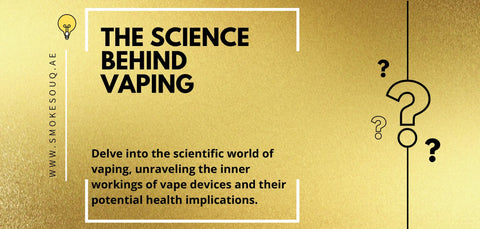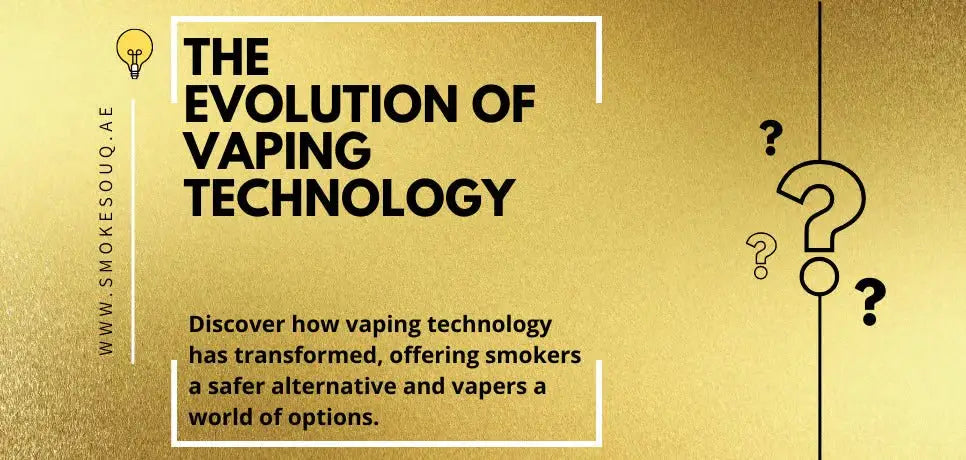The Science Behind Vaping: how Vape Devices Work and their Effects

Exploring the Mechanics of Vaping and Its Implications for Well-Being
Introduction
Vaping, with its skyrocketing popularity, has revolutionized the smoking landscape by offering a potentially safer alternative to traditional cigarettes. This shift raises important questions about the science behind vaping. How do vape devices work, and what are the potential health effects associated with this rapidly growing industry? In this article, we will take an in-depth look at the scientific mechanisms involved in vaping, aiming to provide you with a clearer understanding of this smoke-free revolution and its broader implications for health and lifestyle choices.
The Anatomy of a Vape Device
The components of a vape device work in concert to deliver vapor:
The Powerhouse - The Battery: At the core of every vape device lies the battery, which is responsible for supplying the necessary power to heat the coil. This process transforms the e-liquid into vapor, a critical aspect of how vape devices work. Batteries vary in size and power output, affecting both vapor production and usage duration, making them a fundamental element of the vaping experience.
Where the Magic Happens - The Atomizer: This contains the coil and wick, acting as the heart of the vape device. Upon activation, the battery transmits power to the coil, generating heat that vaporizes the e-liquid-saturated wick—typically made from cotton or other absorbent materials.
The Vital Ingredient - E-Liquid: E-liquid, commonly known as vape juice, features a mix of propylene glycol (PG), vegetable glycerin (VG), flavorings, and optional nicotine. When drawn into the heated coil, it effectively transforms into vapor, which can be inhaled, thus offering an alternative method of nicotine consumption versus traditional smoking.
A Breath of Fresh Air - The Mouthpiece: This is the part of the device from which the user inhales the vapor, completing the process of vaping.
The Science of Vaporization
At the heart of vaping is vaporization. The battery activates the coil, which then heats up rapidly. This heat is transferred to the e-liquid through the wick, resulting in the vaporization of the liquid. The vapor produced mimics the sensation of smoking but without the harmful byproducts of combustion found in traditional cigarettes.
Why Vape Devices are a Safer Alternative
The allure of vape devices as a less harmful alternative stems from their significant reduction in harmful compounds. Unlike traditional cigarettes, which rely on burning tobacco to produce smoke and ash, vape devices operate without combustion. This lack of burning results in no tar and dramatically reduces the amount of harmful substances inhaled. While it's true that vape device vapor may still contain some toxicants, they are often present at levels much lower than those found in cigarette smoke. However, it is crucial to remember that the long-term implications of vaping are still under investigation, and it’s prudent to consider that vaping is not entirely devoid of risks.
Assessing the Health Effects
Vaping is frequently promoted as a less harmful choice compared to smoking, but what does current scientific research reveal about its health effects?
Diminished Exposure to Harmful Chemicals: Research shows that vapor from vape devices generally contains fewer toxic substances compared to the smoke produced by traditional cigarettes. However, users should remain aware that this does not mean vaping is free from health hazards.
Nicotine Dependency: Many vape devices deliver nicotine, which can lead to addiction—a significant concern among users. Understanding the addictive nature of nicotine is vital for responsible use of vape products.
Potential Long-Term Effects: Given that vaping is a relatively new phenomenon, comprehensive studies on its long-term health effects are ongoing. Current areas of concern include possible respiratory issues and cardiovascular health risks associated with prolonged vaping.
Conclusion
A thorough understanding of the science behind vaping is essential for anyone contemplating the switch from traditional smoking to vape devices. While vaping presents a potentially safer alternative by reducing many harmful elements found in cigarette smoke, it is critical to recognize that it carries its own set of risks. Ongoing research is key to uncovering the extended health ramifications of vaping. For individuals considering vaping as an alternative to traditional smoking, it’s important to critically assess the available evidence and make a well-informed decision.
Ultimately, whether you are a smoker seeking to quit or simply curious about the science of vaping, gaining this knowledge will empower you to navigate the world of vape devices with greater awareness and understanding.
Ready to Explore Vaping?
If you're interested in exploring the latest vaping devices and accessories, be sure to visit SmokeSouq for a wide selection of options designed to enhance your vaping experience.
Sources:
- Royal College of Physicians - "Nicotine without smoke: Tobacco harm reduction
- CDC - "Smoking & Tobacco Use - Electronic Cigarettes
- American Heart Association - "The Facts About Vaping



Leave a comment
This site is protected by hCaptcha and the hCaptcha Privacy Policy and Terms of Service apply.